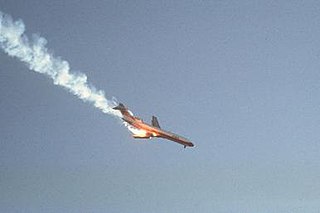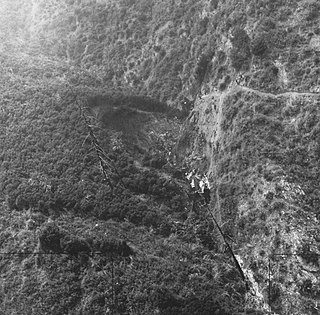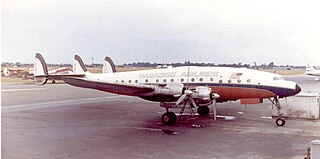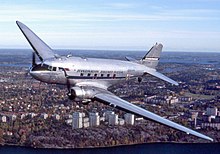Arrow Air was a passenger and cargo airline based in Building 712 on the grounds of Miami International Airport (MIA) in Miami-Dade County, Florida. At different times over the years, it operated over 90 weekly scheduled cargo flights, had a strong charter business and at one point operated scheduled international and domestic passenger flights. Its main base was Miami International Airport. Arrow Air ceased operations on June 29, 2010, and filed for Chapter 11 bankruptcy protection on July 1, 2010. It was then liquidated.

Pacific Southwest Airlines Flight 182 was a scheduled flight of Pacific Southwest Airlines (PSA) from Sacramento to Los Angeles and San Diego. On September 25, 1978, the Boeing 727-214 serving the flight, registration N533PS, collided with a private Cessna 172 light aircraft, registration N7711G, over San Diego, California. It was Pacific Southwest Airlines' first fatal accident, and it remains the deadliest air disaster in California history. At the time, it was the deadliest air crash to occur in the United States, and remained so until American Airlines Flight 191 in May 1979.

United Air Lines Flight 615 was a US transcontinental east–west airline service from Boston to Hartford, Cleveland, Chicago, Oakland and San Francisco. On August 24, 1951, the Douglas DC-6 with registration N37550 operating the service, crashed on approach to Oakland, causing the death of all 44 passengers and 6 crew members on board.

Eastern Air Lines Flight 663 was a domestic passenger flight from Boston, Massachusetts, to Atlanta, Georgia, with scheduled stopovers at John F. Kennedy International Airport, New York; Richmond, Virginia; Charlotte, North Carolina; and Greenville, South Carolina. On the night of February 8, 1965, the aircraft serving the flight, a Douglas DC-7, crashed near Jones Beach State Park, New York, just after taking off from JFK Airport. All 79 passengers and five crew aboard perished.

On 10 June 1960, a Fokker Friendship passenger aircraft operated by Trans Australia Airlines (TAA) was on approach at night to land at Mackay, Queensland, Australia when it crashed into the sea. All 29 people on board Trans Australia Airlines Flight 538 were killed.

Hughes Airwest Flight 706 was a regularly scheduled flight operated by American domestic airline Hughes Airwest from Los Angeles, California to Seattle, Washington, with several intermediate stops. On Sunday, June 6, 1971, the McDonnell Douglas DC-9 serving as Flight 706 departed Los Angeles just after 6 p.m. en route to Seattle as a McDonnell Douglas F-4 Phantom II of the United States Marine Corps was approaching Marine Corps Air Station El Toro near Irvine at the end of a flight from Naval Air Station Fallon in Nevada. The two aircraft collided in midair over the San Gabriel Mountains near Duarte, killing all 49 aboard the DC-9 and the F-4 pilot; the F-4 radar intercept officer ejected and survived.

United Air Lines Flight 608 was a Douglas DC-6 airliner, registration NC37510, on a scheduled passenger flight from Los Angeles to Chicago when it crashed at 12:29 pm on October 24, 1947 about 1.5 miles (2.4 km) southeast of Bryce Canyon Airport, Utah, United States. None of the five crew members and 47 passengers on board survived. It was the first crash of a DC-6, and at the time, it was the second-deadliest air crash in the United States, surpassed by Eastern Air Lines Flight 605 by only one fatality.

Pan Am Flight 7 was a westbound round-the-world flight operated by Pan American World Airways. On November 8, 1957, the Boeing 377 Stratocruiser 10-29 serving the flight, named Clipper Romance of the Skies, crashed in the Pacific Ocean en route to Honolulu International Airport from San Francisco. The crash killed all 36 passengers and 8 crew members.

West Coast Airlines Flight 956 was a scheduled commercial flight in the western United States which crashed on October 1, 1966, approximately 5.5 miles (9 km) south of Wemme, Oregon, southeast of Portland. Thirteen passengers and five crew members were aboard, but none survived. In its first week of service, the aircraft was destroyed by the impact and subsequent fire.

On 4 September 2000, a chartered Beechcraft 200 Super King Air departed Perth for a flight to the mining town of Leonora, Western Australia. The aircraft crashed near Burketown, Queensland, Australia, resulting in the deaths of all eight occupants. During the flight, the aircraft climbed above its assigned altitude. When air traffic control (ATC) contacted the pilot, the pilot's speech had become significantly impaired, and he was unable to respond to instructions. Three aircraft intercepted the Beechcraft, but were unable to make radio contact. The aircraft continued flying on a straight north-easterly heading for five hours, before exhausting its fuel and crashing 40 mi (65 km) south-east of Burketown. The crash became known in the media as the "ghost flight".

American Airlines Flight 63 was an American Airlines DC-3 nicknamed the Flagship Missouri that crashed on October 15, 1943, near Centerville, Tennessee, after ice formed on its wings and propeller. All eight passengers and three crewmembers died. This was the second fatal crash of an aircraft designated Flight 63, occurring 2+1⁄2 months after the crash of the Flagship Missouri’s sister ship, the Flagship Ohio.

American Airlines Flight 910, a four-engine Douglas DC-6 propliner, collided in mid-air with a single engine Temco Swift on final approach to Dallas Love Field on June 28, 1952, over Dallas, Texas. The DC-6 was carrying 55 passengers and 5 crew members from San Francisco, California. The DC-6 landed with no injuries to any of its 60 occupants, while both occupants of the two-person Swift died when their aircraft impacted the ground.

American Airlines Flight 28 was a scheduled domestic passenger flight that crashed on October 23, 1942, in Chino Canyon near Palm Springs, California, United States, after being struck by a United States Army Air Forces B-34 bomber. The B-34 suffered only minor damage, and landed safely at the Army Airport of the Sixth Ferrying Command, Palm Springs.

Chicago and Southern Air Lines Flight 4 was a regularly scheduled flight from New Orleans, Louisiana to Chicago, Illinois via Jackson, Mississippi; Memphis, Tennessee; and St. Louis, Missouri operated with a Lockheed Model 10 Electra. On August 5, 1936, after departing from Lambert-St. Louis International Airport, the flight crashed in a farm field near the Missouri River. All 6 passengers and 2 crew members were killed in the crash.

Paradise Airlines Flight 901A was a scheduled passenger flight from San Jose Municipal Airport to Tahoe Valley Airport in the United States. On March 1, 1964, the Lockheed L-049 Constellation serving the flight crashed near Genoa Peak, on the eastern side of Lake Tahoe during a heavy snowstorm, killing all 85 aboard and destroying the plane. After the crash site was located, the recovery of the wreckage and the bodies of the victims took most of a month. Crash investigators concluded that the primary cause of the accident was the pilot's decision to attempt to land at Tahoe Valley Airport when the visibility was too low due to clouds and snowstorms in the area. After aborting the landing attempt, the flight crew lost awareness of the plane's location as it flew below the minimum safe altitude in mountainous terrain. The pilot likely tried to fly through a low mountain pass in an attempt to divert to the airport in Reno, Nevada, and crashed into the left shoulder of the pass. At the time, it was the second-deadliest single-plane crash in United States history, and remains the worst accident involving the Lockheed L-049 Constellation.

Pan Am Flight 923 was a Douglas DC-4 operating from Seattle, Washington to Juneau, Alaska, which crashed into Tamgas Mountain on Annette Island, Alaska, on October 26, 1947. All 18 passengers and crew on board were killed.

On 4 August 2018, a de Havilland Canada DHC-2 Beaver aircraft operated by K2 Aviation crashed in poor weather near Denali, Alaska, United States. All five people on board survived the crash, but died before rescuers were able to arrive at the scene. The five people consisted of the pilot and four Polish tourists.

The crash of Delta Air Lines Flight 318 was an accident involving a Douglas DC-3 of the American airline Delta Air Lines 13 miles (21 km) east of Marshall, Texas, United States on May 17, 1953, killing all but one of the 20 people on board.

















